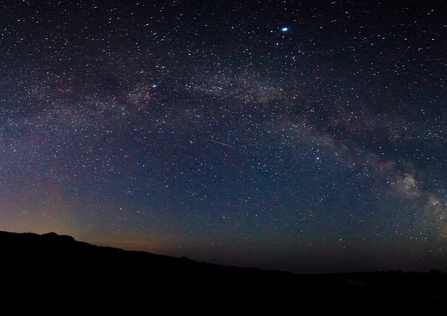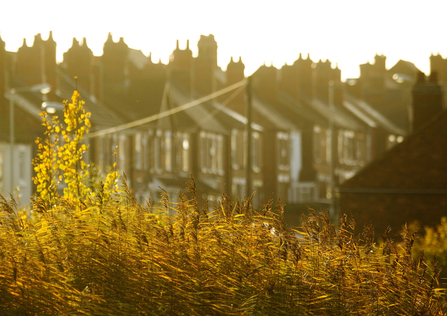The oak tree in my garden is listing dangerously after a battering from the weekend’s storms. The decision to call in the tree surgeon to take it down is not an easy one. This majestic giant, with its many layered crown and leaves just turning a glorious autumn rust colour, has taken a century to grow. It’s the dominant personality in our garden. We stand and watch as the chainsaws whine and limb after limb comes crashing to the ground. And as the dismembering proceeds, something strange happens. I become less and less attached to my shrinking oak tree. And when the bare trunk finally keels over with sad, unceremonious thud, I don’t really feel it’s my tree at all.
Planning to fail

Photo credit, Ed Marshall
The phrase “death by a thousand cuts” may be a tired cliché, but it is as relevant as ever in the British landscape. In the fields outside our towns, the new houses come. The road gets widened and spawns multiple limbs. Pavements with bright street lamps appear. The hedges and tree lines are removed to make way for this progress. Bit by bit, the patchwork world of sinuous green is replaced by one of grey tidy-ness and straight lines. And this slow but relentless tide gradually changes our perception and sense of what is normal in rural Devon. Our baselines shift, we become used to a world where true darkness at night-time is alien, where uniform bright green fields and slimline, manicured hedges are the standard.
But there is one thing we have in Britain that most other countries don’t. One line of defence, that can be deployed to help encourage the best and prevent the worst. And that’s our land use planning system. Set up in the late 1940s, it was originally designed to prevent unsightly ribbon development and plan new settlements logically. In more recent times it’s been broadened to help ensure the right mix of houses, provision of green spaces, protection of the most important environmental assets. And crucially, it allows local communities to have a say in what gets built in their neighbourhood.
A crowd pleaser for less scrupulous developers perhaps, but it doesn’t sit terribly comfortably with the UK’s ambition to have world leading environmental laws.
Great if you happened to be a conservationists or a concerned member of the local community. Not so great if you’re a housing developer, wanting to build as quickly and cheaply as possible. Which is why successive governments have come under intense pressure from parts of the building industry to weaken the system.
And that’s exactly what our government is proposing to do in the Planning White Paper, which is currently out for public consultation. The “biggest shake up of the planning system since WW2” is how it’s been badged. Among the proposals are creating zones where development would be granted automatic permission in principle, and where neither local communities or local government would have any say in where or how it takes place. Weakening safeguards like the Environmental Impact Assessment, which protect our best wildlife habitats from damage. And plenty of exemptions from the principle of environmental net gain for large developments. Derogatory references to “newt counting” haven’t helped alleviate fears about the intentions behind this either. A crowd pleaser for less scrupulous developers perhaps, but it doesn’t exactly sit comfortably with the UK’s ambition to have world leading environmental laws.
The planning system is far from perfect, and of course we do need new houses. A thorough review of the system to make it fit for the 21st century and the climate and ecological crises is no bad thing. But the planning system is seldom the true reason why new development doesn’t go ahead, and the great majority of applications are given the go ahead anyway.

We can do a whole lot better than this. We need to stop pitching development and environmental enhancement against each other. New build can generate environmental improvements if done properly. And the planning system should be a mechanism for bringing about this positive change, not just a break to slow down the inevitable degradation. This is where the concept of Wildbelt, which the Wildlife Trusts are advocating, is so exciting. Derived from the 75 year old concept of the Greenbelt, which was intended to stop cities sprawling into the surrounding countryside, Wildbelt is a modern, nature friendly idea fit for the 21st century. It would create a zone where land can be restored, where new habitats can be created, where carbon can be sequestered and where people can have quality access to nature. Wildbelt could extend in and around our cities, our villages and across the wider countryside. Guided by the Nature Recovery Network, it would be the bold and ambitious step we desperately need to start bringing wildlife back on a big scale.
A new, improved land use planning system needs to embrace concepts like Wildbelt, which ask fundamental questions about how we use our land. We have to come to terms with the fact that in the UK our demands for living space, food, timber, and other natural materials far outstrips the total area of the British Isles. We are using land, as well as natural resources like carbon, incredibly inefficiently. Little wonder we keep eating further and further into our natural capital. If we are to provide room our needs, let wildlife expand and allow areas to rest so that they can start sucking up our excess carbon, we need to be a whole lot clever about how we use this most precious and finite of resources. This is the big challenge for our land use planning system, and we can’t hope to win the battle within out it. We need a stronger, better and more proactive system, not a weaker, passive one.
The public consultation lasts until 29th October. So let’s tell the government what we really want the new look planning system to do.
- We want it to properly protect the wildlife habitat that we still have.
- We want it to provide space for doubling the area of wildlife habitat we have across the country through a new Wildbelt.
- We want it to acknowledge the climate emergency and ensure all new build is of the highest eco standards and lowest emissions.
- We want it to raise standard, not lower them.
This is a moment when the government can show that it really means business when it talks about the UK being a leader in the natural environment. And it’s a moment when we, the British people, can make it clear that we don’t accept anything less.

